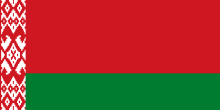Vyshyvanka
As vyshyvanka ( Ukrainian Вишиванка ; Russian Вышиванка ; Belarusian Вышыванка ; in German: embroidery ) refers to traditional East Slavic embroidery patterns, particularly in Ukraine are widespread regions and be seen there as a national treasure. Similar patterns can also be found in Belarus and Russia .
history
Wyschywankas on early medieval clothing are said to have served primarily as talismans. The embroidery was especially applied in places where evil spirits could potentially penetrate the body of the person wearing it: for example along the neckline, the sleeve ends or the shoulders.
The patterns date back to the early Middle Ages, but many variations did not emerge until the 19th century. Archduke Wilhelm Franz of Austria (1895–1948) was a Ukrainian patriot and since the time of the First World War he often wore the Wyschywanka and was therefore called Vasil Wyschywanij (Wilhelm the Embroidered) in Ukrainian, a name that he also got after the war preferred. Wyschywanoho Square in the city of Lviv was named in his honor.
During the Soviet Union , the tradition of the Vyshyvanka was preserved and mass-produced. Nikita Khrushchev always wore an embroidered shirt. The Vyshyvanka pattern is part of the flag of Belarus .
Examples from Ukraine
Individual evidence
- ↑ У Києві відкрилася виставка вишиванок з усієї України - Новини - Перший канал. In: 1tv.com.ua. Retrieved September 8, 2016 .
- ^ Jill Condra: Encyclopedia of National Dress: Traditional Clothing Around the World [2 Volumes] . ABC-CLIO, 2013, ISBN 978-0-313-37637-5 , pp. 624 ( google.com [accessed September 8, 2016]).
- ↑ Фабрика Деснянка ( Memento from July 6, 2013 in the web archive archive.today )
- ↑ Вишиванка - одяг політичний









